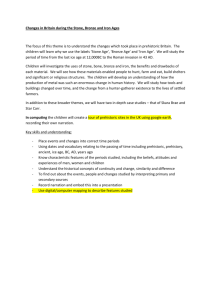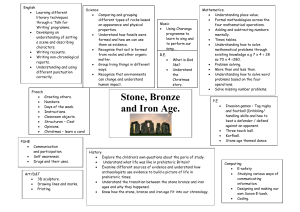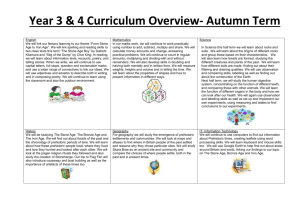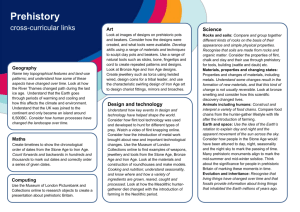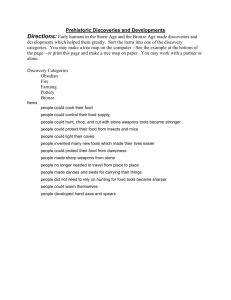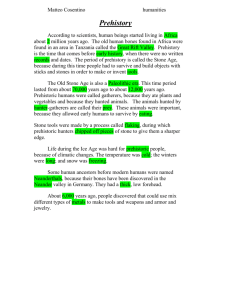Block Outcomes - Hamilton Trust
advertisement
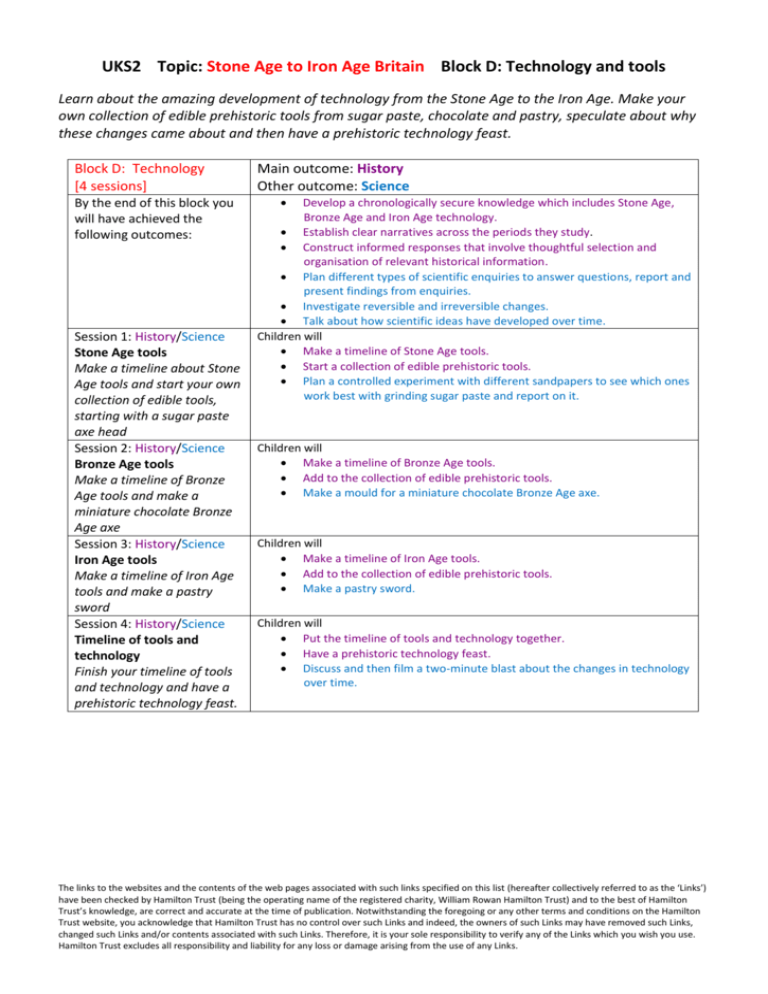
UKS2 Topic: Stone Age to Iron Age Britain Block D: Technology and tools Learn about the amazing development of technology from the Stone Age to the Iron Age. Make your own collection of edible prehistoric tools from sugar paste, chocolate and pastry, speculate about why these changes came about and then have a prehistoric technology feast. Block D: Technology [4 sessions] By the end of this block you will have achieved the following outcomes: Session 1: History/Science Stone Age tools Make a timeline about Stone Age tools and start your own collection of edible tools, starting with a sugar paste axe head Session 2: History/Science Bronze Age tools Make a timeline of Bronze Age tools and make a miniature chocolate Bronze Age axe Session 3: History/Science Iron Age tools Make a timeline of Iron Age tools and make a pastry sword Session 4: History/Science Timeline of tools and technology Finish your timeline of tools and technology and have a prehistoric technology feast. Main outcome: History Other outcome: Science Develop a chronologically secure knowledge which includes Stone Age, Bronze Age and Iron Age technology. Establish clear narratives across the periods they study. Construct informed responses that involve thoughtful selection and organisation of relevant historical information. Plan different types of scientific enquiries to answer questions, report and present findings from enquiries. Investigate reversible and irreversible changes. Talk about how scientific ideas have developed over time. Children will Make a timeline of Stone Age tools. Start a collection of edible prehistoric tools. Plan a controlled experiment with different sandpapers to see which ones work best with grinding sugar paste and report on it. Children will Make a timeline of Bronze Age tools. Add to the collection of edible prehistoric tools. Make a mould for a miniature chocolate Bronze Age axe. Children will Make a timeline of Iron Age tools. Add to the collection of edible prehistoric tools. Make a pastry sword. Children will Put the timeline of tools and technology together. Have a prehistoric technology feast. Discuss and then film a two-minute blast about the changes in technology over time. The links to the websites and the contents of the web pages associated with such links specified on this list (hereafter collectively referred to as the ‘Links’) have been checked by Hamilton Trust (being the operating name of the registered charity, William Rowan Hamilton Trust) and to the best of Hamilton Trust’s knowledge, are correct and accurate at the time of publication. Notwithstanding the foregoing or any other terms and conditions on the Hamilton Trust website, you acknowledge that Hamilton Trust has no control over such Links and indeed, the owners of such Links may have removed such Links, changed such Links and/or contents associated with such Links. Therefore, it is your sole responsibility to verify any of the Links which you wish you use. Hamilton Trust excludes all responsibility and liability for any loss or damage arising from the use of any Links. UKS2 Topic: Stone Age to Iron Age Britain Block D: Technology and tools Resources needed Session 1 Provided: Stone tool typology; Instructions on how to grind sugar paste; Instructions on how to make a tool collection box. You will need: Sugar paste; Sandpaper. Session 2 Provided: Bronze tool typology; Instructions on how to cast a miniature chocolate axe. You will need: Air-drying clay or FiMo; Alginart moulding powder and water (Warning - keep instructions away from chn); Cooking chocolate. Session 3 Provided: Iron tool typology; Instructions on how to make a pastry axe. You will need: Ready-made pastry; Oven trays. Session 4 Provided: Information on the developments in technology; Template for ‘Two Minute Blast’ to camera. You will need: Video camera. The links to the websites and the contents of the web pages associated with such links specified on this list (hereafter collectively referred to as the ‘Links’) have been checked by Hamilton Trust (being the operating name of the registered charity, William Rowan Hamilton Trust) and to the best of Hamilton Trust’s knowledge, are correct and accurate at the time of publication. Notwithstanding the foregoing or any other terms and conditions on the Hamilton Trust website, you acknowledge that Hamilton Trust has no control over such Links and indeed, the owners of such Links may have removed such Links, changed such Links and/or contents associated with such Links. Therefore, it is your sole responsibility to verify any of the Links which you wish you use. Hamilton Trust excludes all responsibility and liability for any loss or damage arising from the use of any Links.
